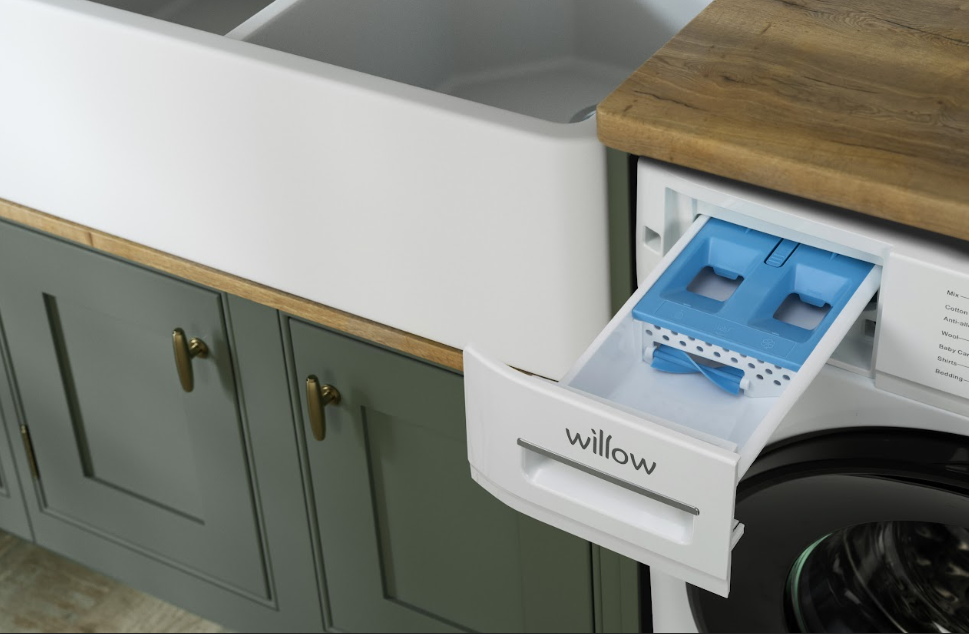How to clean a washing machine drawer
Did you know that 39 per cent of Brits prefer to throw away their dirty appliances instead of cleaning them? This statistic is all the more shocking when you realise how quick and easy it really is to keep your appliances clean, particularly a washing machine.
A washing machine is a staple appliance in most British homes, keeping our clothes clean and fresh, but cleaning the machine itself often goes overlooked. So, in this article, we’ll discuss the importance of cleaning every part of a washing machine, exploring suitable cleaning agents and providing step-by-step guides on how to clean the washing machine drawer and seal.
Why is it important to wash all parts of a washing machine?
Ensuring your washing machine is clean is more than just keeping up appearances; it is essential for several reasons:
Hygiene
Washing machines are an ideal breeding ground for mould and bacteria to grow because they are often damp and warm. By regularly cleaning all parts of your washing machine, you can prevent the buildup of this bacteria.
Machine performance
It's no secret that a clean washing machine operates more efficiently, and by regularly cleaning your machine, you can improve drainage, prevent buildup, and ensure your washing machine runs as it should.
Cleaner clothes
If your washing machine isn’t clean, how can it clean your clothes? Residue from detergent and dirt can build up in parts of your washing machine. A clean machine will help ensure your clothes are properly cleaned and prevent damage.
Odours
If you’ve noticed an unpleasant smell emanating from your washing machine, it could need cleaning. Regular maintenance eliminates these odours and keeps your clothes smelling fresher.
What can I use to clean a washing machine?
There are several ways to clean a washing machine, but before we delve into the specific cleaning methods, it is important to understand the best cleaning agents to maintain your machine.
White vinegar
As a natural disinfectant, white vinegar is a great home remedy for cleaning a washing machine. The acidity helps to descale your appliance by breaking down mineral deposits, dissolving residue and destroying bacteria.
Washing machine cleaners
There are several great washing machine cleaners on the market, from household names like Dr Beckmann and Dettol, that target limescale, mould and bacteria to keep your machine clean.
Lemon juice
Lemon juice is another excellent acidic cleaner that is effective against mould and mildew. While breaking down residue and removing bacteria, it also leaves your drum smelling fresh and clean.
Baking soda
Baking soda's abrasiveness, combined with its deodorising properties, makes it an ideal cleaning agent. It not only easily removes stains but also neutralises odours and cleans the inside of your machine.
How to clean a washing machine drawer
The washing machine drawer is an integral part of your machine, and to ensure it can continue dispensing detergent and cleaning your clothes efficiently, it requires regular cleaning. Here we put together a step-by-step guide on how to keep the drawer clean:
Remove
Start by gently removing the drawer; this can be done by pressing the release button towards the back
Disassemble
To thoroughly clean the drawers, it's essential to disassemble the components, such as any compartments, for detergent and softener.
Soak
Place all the components of the drawer into warm, soapy water and let them sit for at least half an hour to loosen any dirt or mould.
Scrub
Using a sponge or toothbrush, scrub away any dirt on the surface, paying particular attention to the corners where there will be the most buildup.
Rinse
After cleaning the drawer, completely rinse it with clean water, ensuring all cleaning substances are removed.
Check
Before reinserting, check the area that houses the drawer for mould or detergent residue. If there is visible buildup, use the toothbrush to gently remove it before washing it away with warm water.
Dry
Allow the drawer to completely dry before reassembling the components and inserting it back into the washing machine.
How to clean a washing machine seal
Another overlooked part of the washing machine is the rubber seal around the door. This area is a prime location for mould growth, so it must be regularly cleaned.
Start by inspecting the interior and exterior of the seal for any visible dirt or debris and pick out any large particles.
To kill any growing mould and bacteria, you will need to mix a solution of white vinegar and water together. Soak a clean cloth in the mixture to dampen it and begin gently wiping the entire seal.
Pay close attention to crevices where mould is likely to be hidden, and if needed, use an old toothbrush.
If necessary, repeat this process until the seal is completely clean; there may be a few stubborn areas that require more attention.
Then, use another clean and dry cloth to wipe any remaining moisture from the rubber seal to avoid more bacteria growth.
Finish by leaving the washing machine door ajar to allow air to flow throughout.
Is it time for a new washing machine?
Like most household appliances, washing machines require a little care, attention and maintenance to work efficiently.
Quick, regular cleaning of the drawer, seal, and drum will all go a long way in ensuring your appliance functions as it should and keeps your clothes smelling fresh.
However, if your appliance is looking a little worse for wear and is coming to the end of its life cycle, why not consider investing in a new washing machine?
Home Feeling supplies from an affordable range of washing machines suitable for all homes, and our team is on hand if you have any questions or would like more information.
Get in touch today on support@homefeeling.co.uk or give us a call on 01543 228622.

